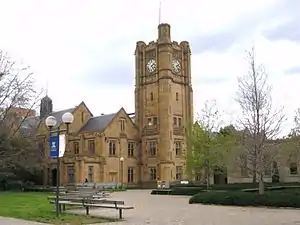Melbourne Conservatorium of Music
The Melbourne Conservatorium of Music is the music school at the University of Melbourne and part of the Faculty of Fine Arts and Music. It is located near the Melbourne City Centre on the Southbank campus of the University of Melbourne.
Degree programs specialising in music performance, composition, musicology, ethnomusicology, conducting, pedagogy and music therapy are taught at the Conservatorium, which also runs an Early Music Studio, and oversees the publishing house Lyrebird Press. It offers graduate programs including certificates and diplomas, and research and coursework awards at the masters and doctoral levels.
History
The teaching of music at the University of Melbourne has been undertaken under a number of administrative structures. The first award of a degree in music (a Bachelor of Music) was recorded in 1879,[1] and the first Chair of Music, endowed by Francis Ormond – known as the Ormond Professor of Music - was occupied from 1891, even though there was not yet a department or faculty of music at the university.
Through the efforts of the first Ormond Professor, G.W.L. Marshall-Hall, this was rectified in 1894 with the founding of the "University Conservatorium", whose leased premises were located in the Queen's Coffee Palace, a six-storey building on the corner of Rathdowne and Victoria Streets, Carlton.[2] The foundation stone for a permanent Conservatorium in Royal Parade, on the University campus, was laid by Dame Nellie Melba on 26 November 1909, and the building, designed by Bates, Peebles & Smart, was opened in 1913. Assisted by a donation of £1,000 from a benefit concert arranged by Melba,[3] which was matched by the Victorian State Government, the concert room now known as Melba Hall was added and opened by the Governor-General, Lord Denman, on 29 October 1913.
The Conservatorium became the Faculty of Music within the University of Melbourne in 1926, and the first Dean was appointed. This was to be the administrative structure for the next 65 years.
Merger and separation
The Faculty of the VCA and Music was created in 2009 from the amalgamation of the University's Faculty of Music and Faculty of the Victorian College of the Arts. Due to dissatisfaction with the merger a divisional structure with two distinct teaching entities was recreated. On 1 January 2012 the two operating divisions became known as the Faculty of the Victorian College of the Arts and Melbourne Conservatorium of Music. In March 2019 the Conservatorium moved to the new Ian Potter Southbank Centre.
Notable people
Ormond Professor of Music
- G.W.L. Marshall-Hall, 1891–1900
- Franklin Peterson, 1901–1914
- G.W.L. Marshall-Hall, 1915
- William Laver, 1915–1925
- Sir Bernard Heinze, 1926–1957
- George Loughlin, 1958–1979
- Michael Brimer, 1980–1989
- Warren Bebbington, 1991–2008
- Gary McPherson, 2009–present
Directors of the University Conservatorium
- G.W.L. Marshall-Hall, 1895–1900
- Franklin Peterson, 1901–1914
- William Laver, 1915–1925
- Sir Bernard Heinze, 1926–1957
- J. Sutton Crow, 1943–1945
- George Loughlin, 1958–1974
Deans of the Faculty of Music
- Bernard Heinze, 1926–1942
- J. Sutton Crow, 1943 (Acting)
- Sir Bernard Heinze, 1944–1952
- Charles Moorhouse, 1953 (Acting)
- Sir Bernard Heinze, 1954–1957
- Donald Cochrane, 1957 (Acting)
- George Loughlin, 1958–1965
- Richard Samuel, 1966
- George Loughlin, 1967–1970
- Raymond Martin, 1971
- George Loughlin, 1972–1974
- Maxwell Cooke, 1975–1980
- Michael Brimer, 1981–1985
- Ronald Farren-Price, 1986–1990
Head of the School of Music within the Faculty of Music, Visual and Performing Arts
- John Griffiths, 1991
- Warren Bebbington, 1992–1994
Deans of the Faculty of Music (re-instituted)
- Warren Bebbington, 1994–2006
- Cathy Falk, 2007 (Acting)
- Cathy Falk, 2008
Directors of the Melbourne Conservatorium of Music
- Gary McPherson. 2011–2019 (Head, School of Music within the Faculty of the VCA and MCM, 2009–2010)
- Richard Kurth. 2019-
Graduates
- Arthur Chanter (-1950)
References
- "History" Melbourne Conservatorium of Music
- Tregear, Peter The Conservatorium of Music, University of Melbourne: An Historical Essay to Mark Its Centenary 1895-1995, p.23
- See report in the Argus, 31 Jan. 1912.
